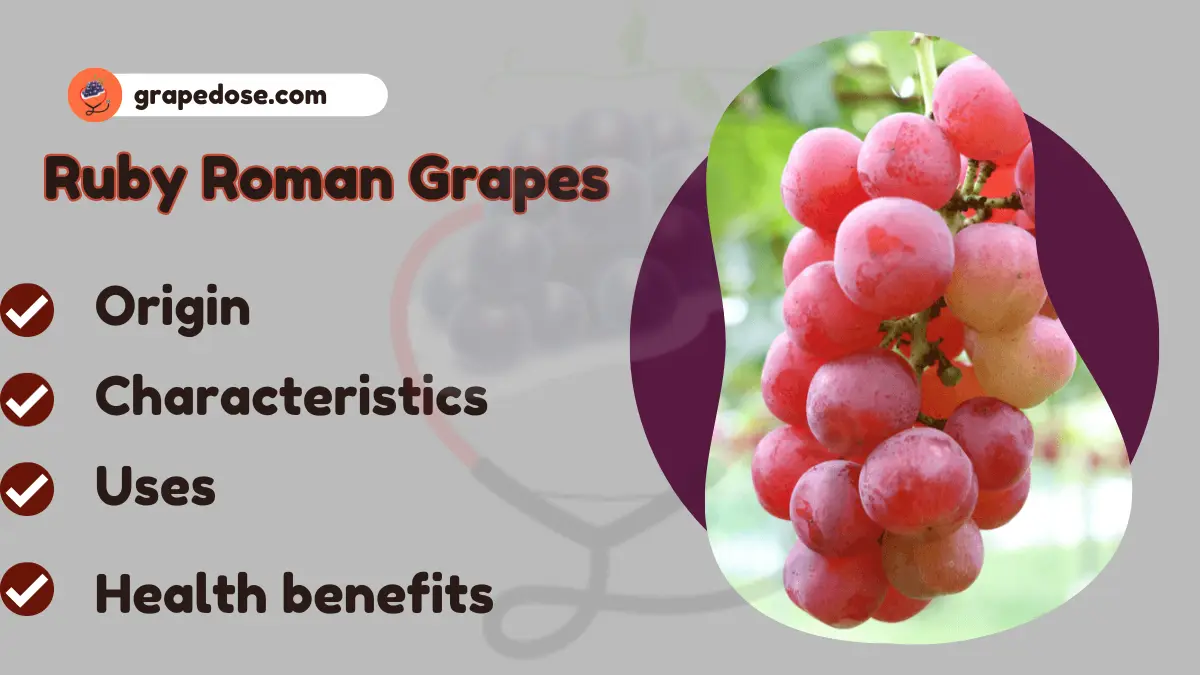Ruby Roman grapes, a jewel in the world of viticulture, have captivated the culinary scene with their extraordinary characteristics and unparalleled taste.[1]
In this article, we delve into the fascinating world of Ruby Roman grapes.

Origin of Ruby Roman grapes
The journey of Ruby Roman grapes began in Japan, where meticulous cultivation practices contribute to their exceptional quality.
The vineyards, nestled in the fertile soils of Japan, employ unique techniques to ensure the grapes reach their full potential.
From the careful selection of vines to the stringent quality control measures, every step in the cultivation process plays a crucial role in defining the grapes’ distinct characteristics.
Characteristics of Ruby Roman Grapes

- These grapes are exceptionally large, often reaching the size of a ping pong ball. They boast a vibrant red color, making them visually striking.
- Ruby Roman grapes are celebrated for their high level of sweetness.
- The sugar content is carefully controlled to meet specific standards, ensuring a delightful and indulgent taste.
- The grapes have a firm and crisp texture, providing a satisfying crunch when bitten into. This characteristic adds to the overall eating experience.
- One of the unique aspects of Ruby Roman grapes is their limited availability.
- The harvest is tightly regulated, and only a small quantity is produced each year, adding to their exclusivity.
- These grapes are primarily grown in the Ishikawa Prefecture of Japan.
- The region’s climate and soil contribute to the distinct flavor profile of Ruby Roman grapes.
- Ruby Roman grapes are held to strict quality standards.
- Each grape must meet specific criteria, including size, color, and sugar content, before being classified as a genuine Ruby Roman.
Health Benefits

1: Supports immune function
Ruby Roman grapes are a good source of vitamin C, which is an important antioxidant that helps boost the immune system. Vitamin C help to protect against infections and promote wound healing.
2: May help prevent cancer
Some studies suggest that anthocyanins in grapes may help protect against certain types of cancer, such as colon cancer and lung cancer.
3: Promotes digestive health
Ruby Roman grapes are a good source of fiber, which is important for digestive health. Fiber help to keep you regular, prevent constipation, and promote the growth of healthy gut bacteria.
4: Boosts heart health
Ruby Roman grapes contain anthocyanins, which are pigments that have been shown to improve heart health. Anthocyanins help to lower blood pressure, reduce inflammation, and improve blood vessel function.
Culinary Uses
- Ruby Roman grapes are eaten raw as a snack or dessert.
- They are also a popular ingredient in fruit salads.
- Ruby Roman grapes can be juiced to make a delicious and refreshing drink.
- Ruby Roman grapes can be made into jam.
- The jam is sweet, tart, and has a deep red color. It is a delicious spread for bread, toast, and waffles.
Ruby Roman grapes stand as a testament to the marriage of nature’s bounty and human ingenuity.
Their origins in Japanese vineyards to global recognition, these grapes have transcended the ordinary, becoming a symbol of luxury and culinary excellence.
As the world continues to savor the unparalleled taste of Ruby Roman grapes, their legacy in the culinary world is destined to endure.
FAQs
Are Ruby Roman grapes genetically modified?
No, Ruby Roman grapes are not genetically modified. They are cultivated through traditional methods with a focus on quality and flavor.
What makes Ruby Roman grapes so expensive?
The exclusivity, stringent cultivation methods, and limited production contribute to the high prices of Ruby Roman grapes.
Can I grow Ruby Roman grapes in my backyard?
Cultivating Ruby Roman grapes requires specific conditions, and they are primarily grown in Japan. It may not be feasible to grow them in all regions.
How do I purchase Ruby Roman grapes?
Ruby Roman grapes are often available through high-end grocery stores, specialty markets, or online platforms. Check with local suppliers for availability.
Do Ruby Roman grapes have any side effects?
Ruby Roman grapes are generally safe to consume in moderation. However, individuals with allergies to grapes should exercise caution.

